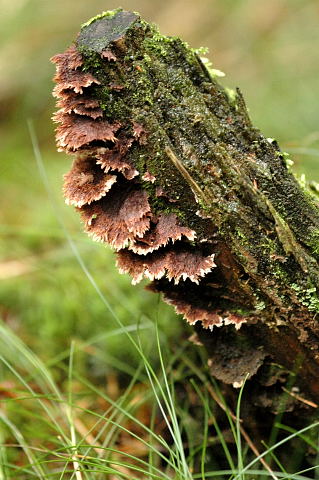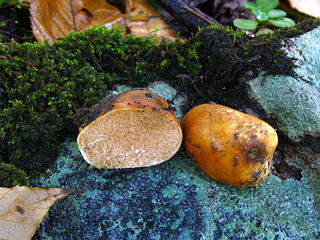Related Research Articles

Miles Joseph Berkeley was an English cryptogamist and clergyman, and one of the founders of the science of plant pathology. The standard author abbreviation Berk. is used to indicate this person as the author when citing a botanical name.
Scortechinia is a genus of fungi in the Ascomycota, of the family Nitschkiaceae.
Spegazzinia is a genus of mitosporic Ascomycota in the Apiosporaceae family. The widely distributed genus contains seven species. This genus is somewhat related to other lobed or ornamented genera such as Candelabrum. No information is available regarding health effects or toxicity. Allergenicity has not been studied. Spegazzinia is usually identified on spore trap samples where it is seen every few weeks. It may also be found in air by culturable (Andersen) samples if a long enough incubation period is provided so that sporulation occurs. Laboratories have never found this organism growing on indoor environmental surfaces. Natural habitat includes soil and many kinds of trees and plants.

Petter Adolf Karsten was a Finnish mycologist, the foremost expert on the fungi of Finland in his day, and known in consequence as the "father of Finnish mycology".
Kotlabaea is a genus of fungi in the family Pyronemataceae.
Sorokina is a genus of fungi in the family Dermateaceae. The genus contains 6 species.
Zoellneria is a genus of fungi in the family Sclerotiniaceae.
Strossmayeria is a genus of fungi in the family Helotiaceae. The genus contains 16 species. The genus was circumscribed by Stephan Schulzer von Müggenburg in Oesterr. Bot. Z. vol.31 on page 314 in 1881.
Roumegueriella is a genus of fungi in the class Sordariomycetes. It consists of three species.

Rimbachia is a genus of fungi in the family Tricholomataceae. The genus contains about ten species with a widespread distribution in tropical regions.
Skepperiella is a genus of fungus in the family Marasmiaceae. The widespread genus contains four species. The genus was circumscribed by Albert Pilát in Bull. Soc. Mycol. France vol.43 on page 56 in 1927.

Ryvardenia is a genus of fungi in the family Polyporaceae. It contains two species, Ryvardenia campyla(Berk.) Rajchenb. (1994) and the type, Ryvardenia cretacea(Lloyd) Rajchenb. (1994), formerly placed in the genus Polyporus. Ryvardenia was circumscribed by Argentinian botanist Mario Rachenberg in 1994.

Thelephora is a genus of fungi in the family Thelephoraceae. The genus has a widespread distribution and contains about 50 species. Fruit bodies of species are leathery, usually brownish at maturity, and range in shape from coral-like tufts to having distinct caps. Almost all species in the genus are thought to be inedible, but Thelephora ganbajun is a gourmet fungus in Yunnan province of southwest China.
Rebentischia is a genus in the Tubeufiaceae family of fungi.
The Uleiellaceae are a family of smut fungi in the order Ustilaginomycetes. The family contains the single genus Uleiella, which has two species.
Holtermannia is a genus of fungi in the order Holtermanniales. Species produce groups of horn-like gelatinous basidiocarps on wood and have associated yeast states. The genus is distributed in southeast Asia and Brazil, and contains six species.

Zelleromyces is a genus of fungi in the family Russulaceae. It was first described by mycologists Rolf Singer and Alexander H. Smith in 1960 to contain hypogeous (underground) fungi with gasteroid fruit bodies that "bleed" latex when they are cut.

Setchelliogaster is a genus of fungi in the order Agaricales. It is incertae sedis with respect to familial placement within the order, although Kirk and colleagues consider it likely aligned with either the Bolbitiaceae or the Cortinariaceae. Species Fungorum class it as in the Bolbitiaceae family. The genus is widespread in warm, dry areas, and originally contained five species, later degraded to 3 species. It was circumscribed by Czech mycologist Zdeněk Pouzar in 1958.
Mycoamaranthus is a genus of fungi in the family Boletaceae. The genus contains three species, found in Australasia, Africa, and Southeast Asia.
References
- ↑ Berkeley MJ. (1857). "On some new fungi". Transactions of the Linnean Society of London. 22 (2): 129–31. doi:10.1111/j.1096-3642.1856.tb00086.x.
- ↑ Burkhardt, Lotte (2022). Eine Enzyklopädie zu eponymischen Pflanzennamen [Encyclopedia of eponymic plant names](pdf) (in German). Berlin: Botanic Garden and Botanical Museum, Freie Universität Berlin. doi:10.3372/epolist2022. ISBN 978-3-946292-41-8 . Retrieved January 27, 2022.
- ↑ "Skepperia Berkeley, 1857". www.gbif.org. Retrieved 1 January 2023.
- ↑ "Skepperia - Search Page". www.speciesfungorum.org. Species Fungorum. Retrieved 27 October 2022.